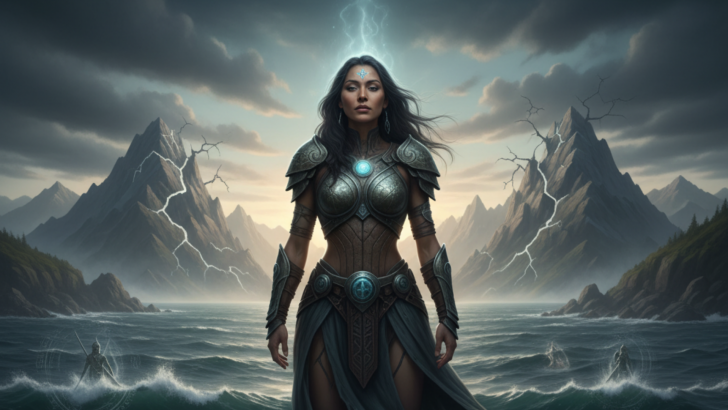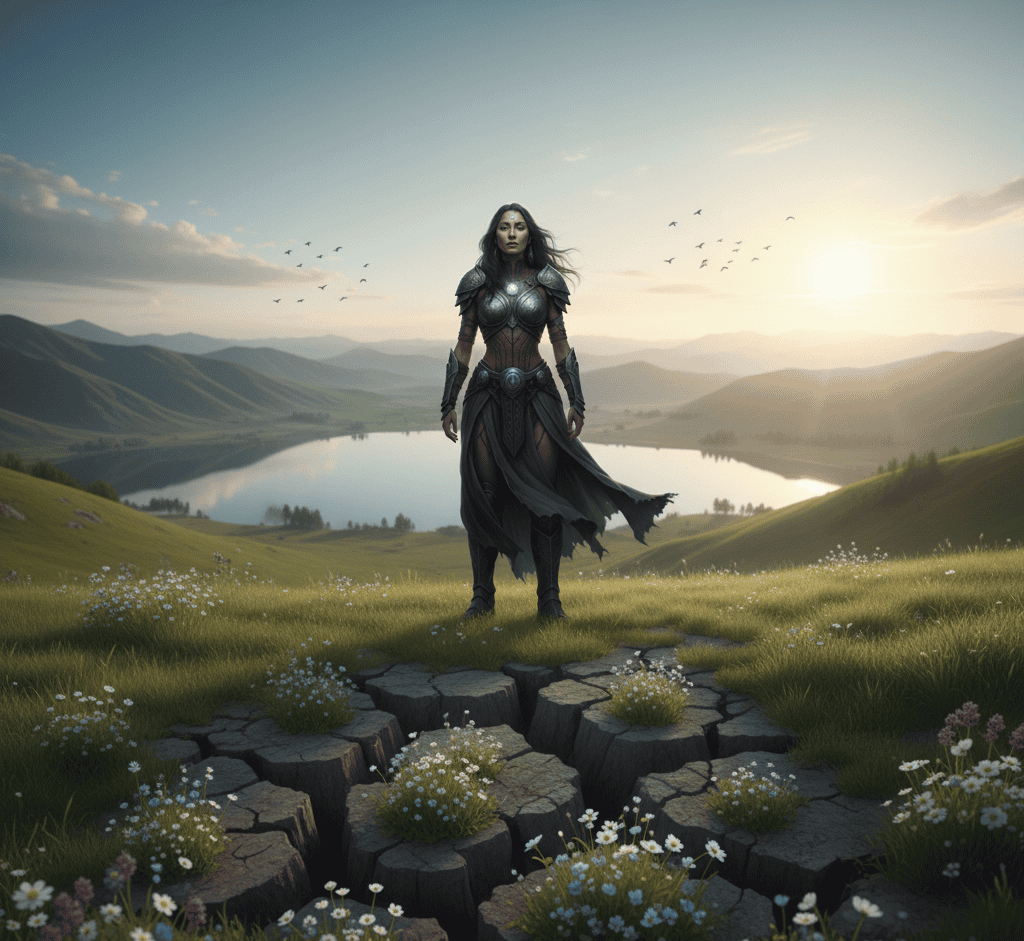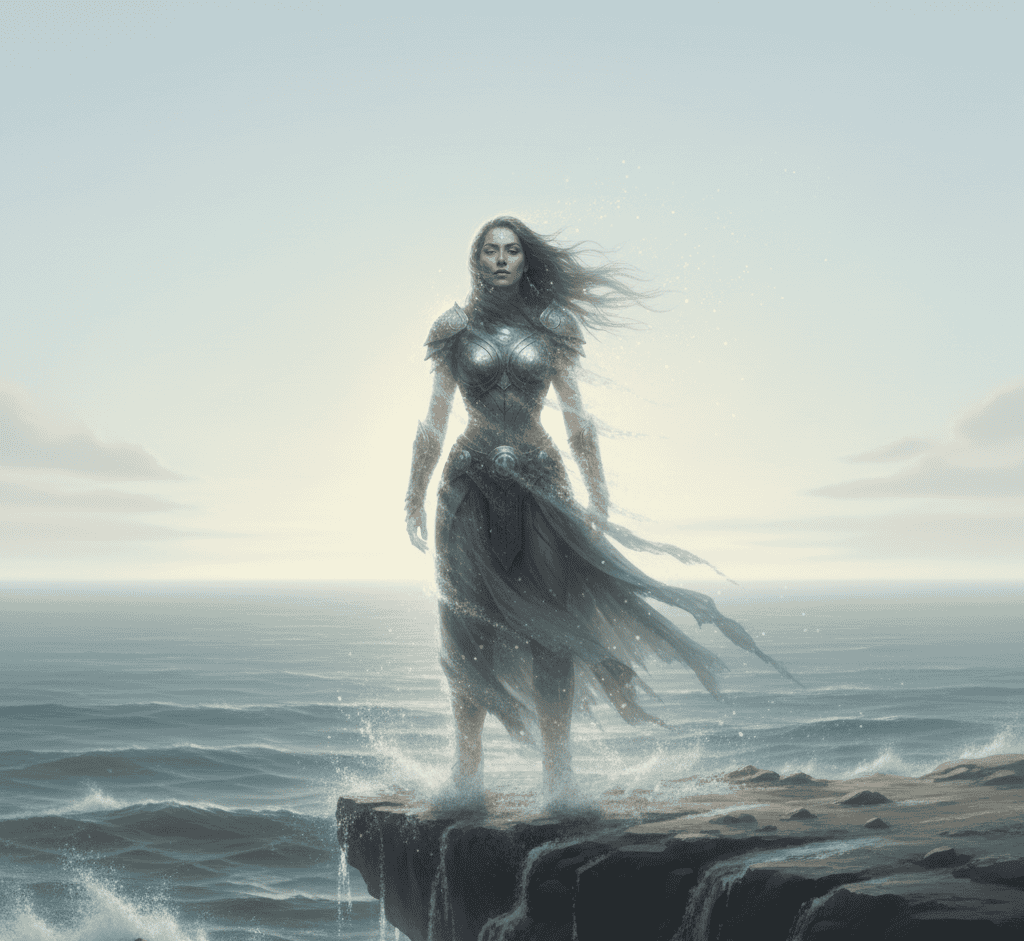Long ago, the people of the Pacific Northwest told a sharp, simple story about a warrior goddess named Qamaits.
She arrived when the world was wild and full of monsters, and she left when the monsters were gone.
This is the tale of how she shaped the land and what it meant when she stepped away.
The Age of Giants
Once, the world was louder. Great creatures wandered across the coast and crushed forests beneath their feet.
They were not gentle giants from bedtime stories. They were dangerous and disorderly.
Rivers changed course when they stamped, and villages lasted only so long as the giants allowed them. People moved at the edges of the world where the shadows were thinner and the ground felt safer.
Then Qamaits came. She is remembered as enormous in spirit, even when described as small enough to sit by a fire.
She did not arrive in silence. The sky seemed to bend toward her, and the sea answered with a steady roar.
Where she walked, the ground trembled, and where she looked, storms paused. The giants heard her and met her with the only thing they knew, force.
Their fights with her were world-changing. Mountains cracked and new valleys appeared. The tales say that battle itself remade the coastline.
What is important is not only that Qamaits fought. It is that she fought with purpose. Her battles were not cruelty for cruelty.
They were a reaction to imbalance. The giants were too large a force for the fragile things that tried to live in their shadow.
She became a kind of correction. People learned courage by watching or by hearing the echo of her deeds.
That courage was practical. It meant better traps for food, stronger nets for storms, and a steadier voice when fear walked into a house at night.
The Turning Point
Victory does not always look like parades and feasting. Sometimes victory looks like a quiet ridge where the grass grows back slower than the stories about it.
Qamaits did what she came to do. One by one, the giants were defeated. Sometimes they became cliffs, and sometimes they faded into the deep places of the earth.
The land itself kept the story in its shape. After the last great combat, a kind of hush came.
The people found themselves hearing birds they had not known. They heard rain where before there had been only the heavy tread of monsters.
That stillness was its own thing to get used to. For many, it was relief. For Qamaits, it was complicated.
She had been a storm in living form, and storms are restless by nature.
The tales suggest she walked among the people after the battles and listened to them sing.
Children made shapes with clay that tried to look like her. Older warriors placed small offerings on the cliffs that had been the sites of fights.
There was gratitude and a kind of sadness. Gratitude because the world was safer.
Sadness because an energy that had once been everywhere no longer shook the air. It is in that space between thanks and loss that the story moves toward departure.
The Choice to Leave
One clear scene repeats in many versions of the tale. Qamaits stands on a high place that looks out over the water.
The light is thin and the horizon is sudden. She looks at the small houses and the slow smoke from the hearths, and she understands that what she was made for has been done.
There are no more giants to challenge the balance. There are no great threats that require her particular kind of rage.
So she chooses to go. The story never makes that choice petty. She does not run from responsibility.
She simply acknowledges the world has room for other kinds of power now. The way she leaves is told in many ways.
Sometimes she steps into a wave and becomes a part of the ocean. Sometimes she climbs to the sky and becomes a star.
Sometimes she changes into an animal that slips through the trees and is never again seen by those who would try to hold her.
The choice to leave is a lesson people return to again and again. It is a reminder that even mighty forces can be temporary.
It is a lesson in allowing a healed place to remain healed. The goddess was not vanquished. She was fulfilled.
There is dignity in leaving when your work is complete. That dignity stayed with the people as a quiet rule about strength and its limits.
The World After Giants
When the giants had fallen and the warrior had gone, the world did not become small. It opened.
Without the shadow of enormous beings, folk grew slower and stronger in different ways.
They learned to shape the earth not only to hide but to welcome. They painted their boats more carefully and sowed seeds with more attention.
Their songs shifted from war cries to naming the weather and naming the seasons.
Qamaits remained in memory not as a ruler but as a guardian who taught by example.
Parents used her story to teach children to stand up to wrongs, but also to let go when needed.
Craftsmen carved small figures to remind themselves that power serves life and not the other way around.
When tempers flared in the community, elders would tell the tale and suggest that some fights are for balance and some fights are for nothing at all.
Over time, the story itself shifted with the people who told it. Sometimes she is fierce and frightening.
Other times, she is a lonely traveler who needs to find a place to rest. That changing portrait is part of what keeps the story alive.
The resonance of Qamaits goes beyond the coast where her story began. She speaks to anyone who has toppled a problem that felt impossible and then been surprised by the quiet that followed.
She speaks to anyone who has had to choose between staying to be needed and leaving to let healing continue.
That tension is a human thing, and that human quality is why the story of the warrior goddess who left the earth does not feel like a faraway myth. It feels like a compass.
If you listen on certain evenings when the waves are soft and the clouds are low, you might hear someone call her name without thinking.
It will be a small sound and a hopeful one. The tale teaches that when giants fall, the space they leave can be used to build beauty.
Qamaits did more than fight monsters. She gave the world a chance to become itself.

自出生以来,我一直感觉到自己与神灵有着紧密的联系。作为一名作家和导师,我的使命是帮助他人在最黑暗的时刻找到爱、幸福和内心的力量。





